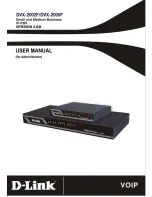
2.3 System Data Control
2.3.1 PC Programming
Description
This PBX can be programmed and administered using a PC. There are two programming methods:
1.
On-site Programming:
System programming/diagnosis can be performed locally by connecting a PC to
the PBX directly.
2.
Remote Programming:
System programming/diagnosis and data upload can be performed from a remote
location.
1.
On-site Programming:
Method
Description
Using the Serial Interface
(RS-232C) port
The PBX has a Serial Interface (RS-232C) port which can be used
for either system administration or SMDR (
®
Message Detail Recording (SMDR)).
Using the USB port
The PC is connected to a USB port (USB Module) attached to a DPT.
Using the LAN interface
Available via the MNT port of the IPCMPR/IPCEMPR card.
Using a modem through
an SLT port
An RMT card must be installed. Assign the floating extension number
of the analogue remote maintenance (default: 599), and dial this
number from the PC to connect to the PBX.
Using an ISDN TA
interface (64 kbps)
through an ISDN
Extension Line
Assign the floating extension number of the ISDN remote
maintenance (default: 699), and dial this number from the PC to
connect to the PBX. The RMT card is not required for this method.
This method is available only when a user-supplied ISDN TA that
supports CAPI is used.
*1
If remote access is disabled through system programming, then this on site programming cannot be done.
2.
Remote Programming:
Method
Description
Using a modem (RMT card)
An RMT card must be installed. The floating extension number of
the analogue remote maintenance must be assigned (default: 599).
PC programming, using a telephone connected in parallel with the
modem, can be done in the following ways:
•
Direct Access
Dial the DIL/DID/DDI number whose destination is the floating
extension number of the analogue remote maintenance.
•
Through DISA
Dial the floating extension number of the analogue remote
maintenance using the DISA feature. (
®
•
Call Transfer
Call an extension (probably the operator), and request a transfer
to the floating extension number of the analogue remote
maintenance. (
®
Feature Guide
415
2.3.1 PC Programming
Summary of Contents for KX-NCP500
Page 13: ...Section 1 Call Handling Features Feature Guide 13...
Page 89: ...User Manual References 1 2 1 Basic Calling Feature Guide 89 1 5 4 Trunk Call Features...
Page 169: ...User Manual References 1 4 2 Holding a Call Feature Guide 169 1 13 1 Call Hold...
Page 185: ...1 7 2 Answering Denying a Paging Announcement Feature Guide 185 1 16 1 Paging...
Page 394: ...394 Feature Guide 1 33 1 Cellular Phone Features SUMMARY...
Page 395: ...Section 2 System Configuration and Administration Features Feature Guide 395...
Page 444: ...444 Feature Guide 2 4 6 Packet Internet Groper PING Confirmation...
Page 445: ...Section 3 Appendix Feature Guide 445...
Page 461: ...Index Feature Guide 461...
Page 467: ...Feature Guide 467 Notes...


































